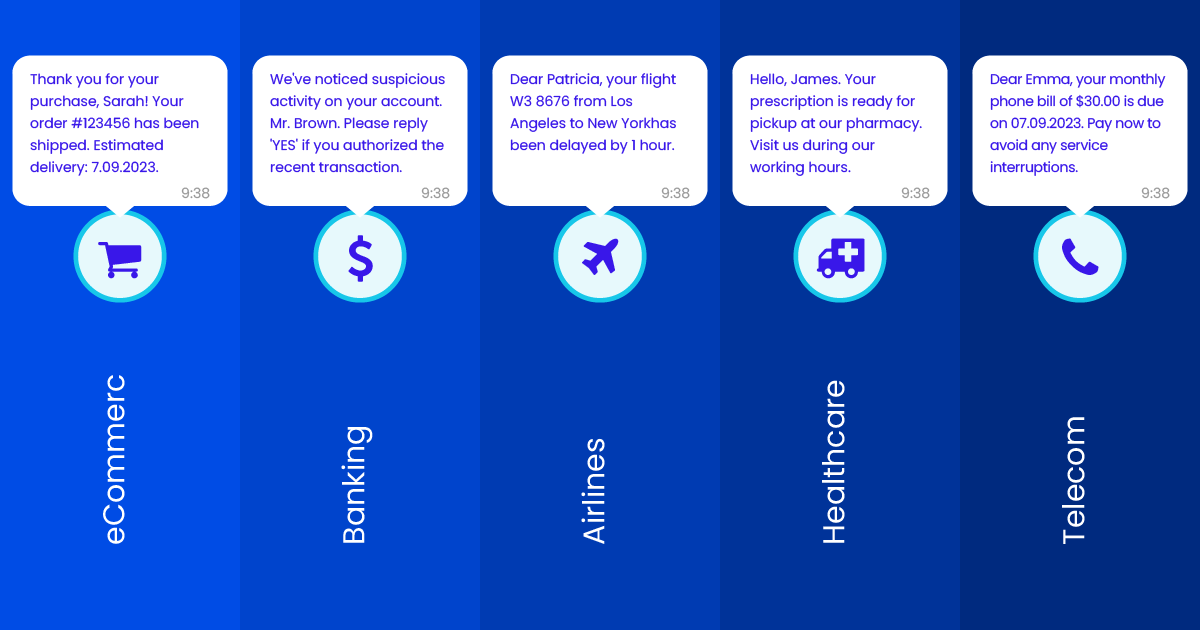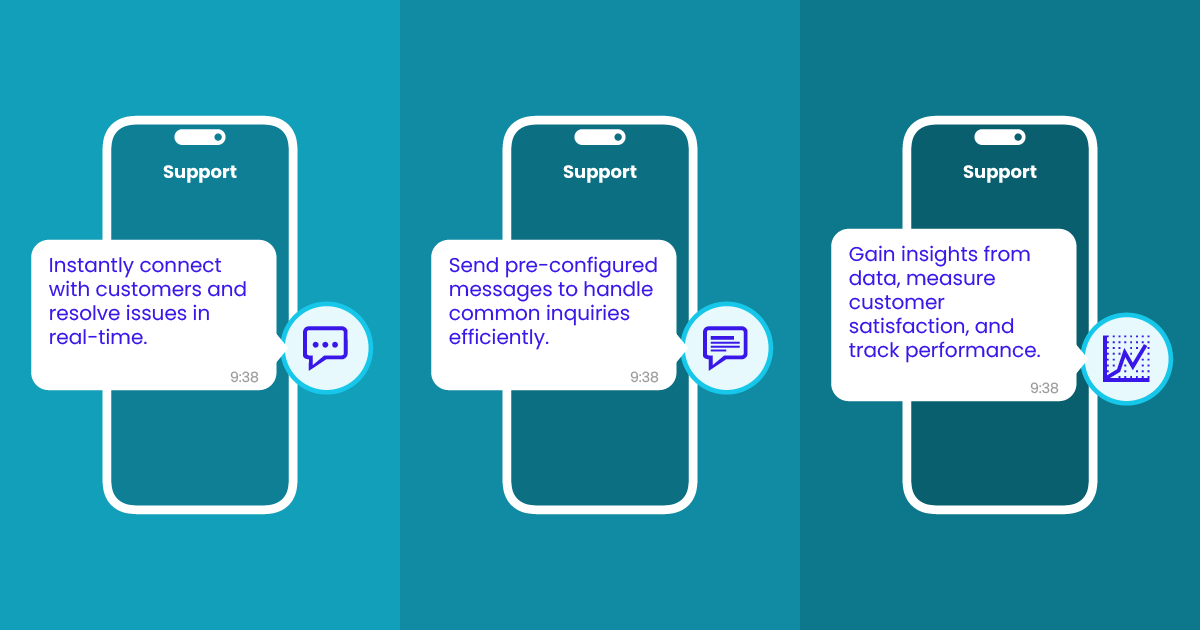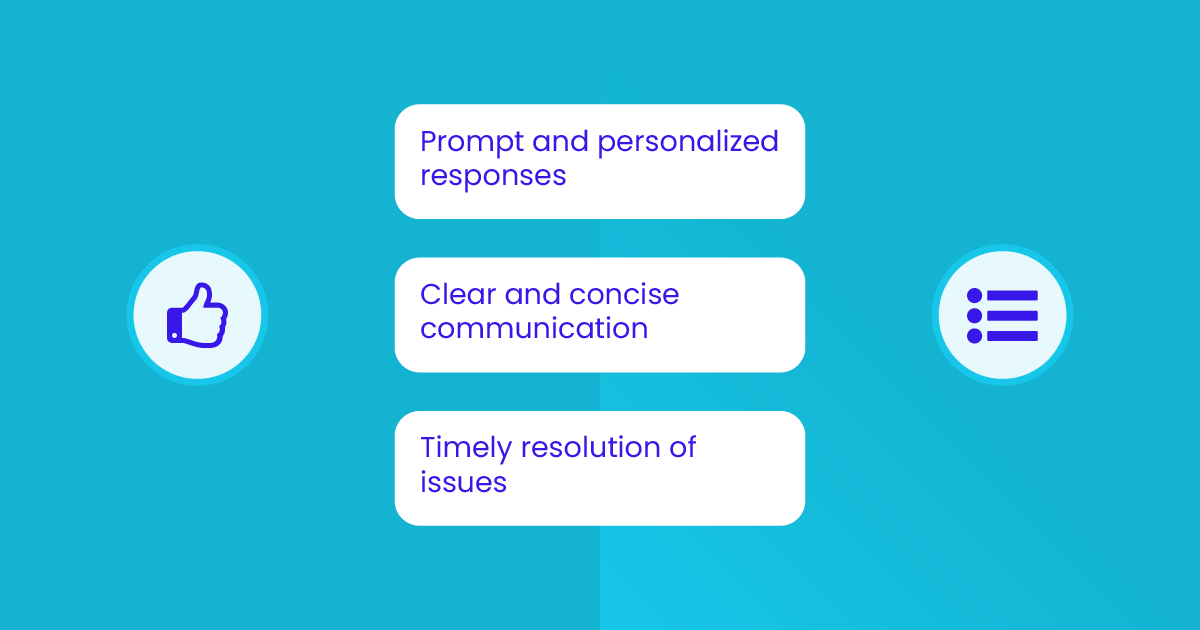How to Successfully Use SMS for Customer Service
Published: Mar 24, 2023
Updated: Jul 12, 2023

Thought about using SMS for customer service? You’re not alone. “How to use messaging for customer service” is one of the biggest queries we get, and for good reason. People spend 1/3 of their waking time on mobile apps; that’s an average of nearly five hours a day.
Your customers are on their phones, so why not meet them where they are? Most people are already communicating with their family and friends through text messaging, so using texting to communicate with businesses is a natural continuation of their daily habits and preferences. And let’s not forget to mention the high open rates of SMS.
In a competitive business world where the difference often comes down to good customer service, being responsive, friendly, and helpful can give you an edge. And providing customer service via SMS ticks all those boxes.
What is SMS Texting for Customer Service?
Also known as customer texting, SMS for customer service is a type of customer support where a business uses text messaging software to interact with and respond to customers. It allows businesses to provide more personalized communication via mobile devices. Customer service texting generally comes in two primary forms: automated and two-way messaging.
SMS Marketing Pricing
We use a pay-as-you-go pricing model, meaning we charge per sent message. No monthly or sign-up fees. SMS marketing costs vary depending on your destination.
Automated messaging involves replying to customer inquiries and providing information using pre-written texts or SMS chatbots. It’s a quick and efficient method of delivering timely responses to customer requests like order statuses and troubleshooting tips. Two-way communication, on the other hand, facilitates real-time messaging between customers and customer service agents. This enables a more tailored approach when it comes to addressing unique customer needs.

Who Benefits from Customer Service Texting?
A variety of industries are known to utilize text messaging for both customer service and support purposes. A few of the common ones include:
eCommerce Industry: Online retailers leverage customer texting to provide shipping updates, delivery notifications, and more, in addition to addressing questions about product availability, refunds, and returns
Financial Services Industry: Banks and financial institutions use customer service messaging to send personal information such as translation alerts, transaction notifications, and credit card balance updates
Travel and Hospitality Industry: SMS customer support is an integral part of the hospitality industry where hotels, airlines, and travel agencies may rely on it to send everything from check-in reminders to booking notifications
Healthcare Industry: Clinics and hospitals make use of SMS support to keep in touch with patients regarding tab test results, appointment reminders, and general health-related information
Retail Industry: Boutiques, showrooms, and other brick-and-mortar stores can take advantage of customer service text messaging to answer customers’ questions about various matters such as store hours and item availability
Advantages of Customer SMS
Sending customer service SMS messages is all about communicating quickly and easily in a way that leaves both parties happy. Just like with SMS marketing, successful text messaging for customer service relies on the inherent strengths of this powerful communication medium.
Direct Communication
SMS is a two-way communication channel, meaning that you can have one-on-one conversations with your customers directly. Customer service agents can respond to questions in the same texting window and complete an entire conversation over one single channel without jumping through different mediums.
Scalable
While texting is a great one-on-one channel, its strength is also in its ability to reach a lot of people at once. If you have an important message to send out, you can use mass texting to immediately reach your entire customer list at once.
Immediate Responses
Not only can you respond quickly to customer issues, but customers can also reply immediately because chances are they have their mobile phone with them at nearly all times. This allows you to quickly solve problems and move on to the next one.
Clear and Concise
SMS messages are short, but what may seem like a limitation is actually one of their strengths. Texting is all about being concise and straight to the point. Most emails go unread because people want the information they need quickly.
SMS encourages you to be clear in your messaging and convey things in as few words as possible. This saves time for both your service reps and the customers.
Cost-Effective
Texting is significantly cheaper than phone calls and requires less time and customer service reps to take care of the same number of incoming requests. By text messaging customers, you can divert a high volume of calls that would otherwise overwhelm your team members and help your customer a lot quicker.
Customer Satisfaction
Not only is texting quicker than calling or emailing, but it also leads to faster resolutions to both simple and complicated customer service messages and requests. Whereas emails or phone calls can feel more formal and detached, you can connect on a more personal level and make your customers feel heard with an SMS. This way, you can significantly enhance the customer service experience.
Integration
You can integrate your SMS communications with your overall CRM system or help desk and ticketing platform for an omnichannel experience. This enables you to follow up, see what previous customer interactions you’ve had, identify customer pain points, and make offers and suggestions that are relevant to your customers.

Top Features of an SMS Customer Service Platform
There are certain features you’ll want to keep in mind when choosing the right SMS platform that offers texting for customer service. These include:
Two-Way Communication: Look for a platform that supports two-way messaging. This makes it easy for customers to reach out and engage in real-time communications with customer support agents
Automation: An SMS customer service platform will ideally have automation capabilities like chatbot marketing and pre-programmed replies, which help boost efficiency and allow the support team to focus on matters that call for the expertise of a human agent
Analytics and Reporting: Robust analytics features come in handy when using SMS for business customer service. They enable you to monitor and assess details like response times, customer satisfaction, and other valuable insights
Personalization: Another key element in customer service and support messaging is personalization. This essentially allows you to tailor communications to individual customers and enhance the customer experience
Easy Integration: Make sure the customer service platform integrates seamlessly with existing systems like CRM software, ticketing systems, and help desk solutions. This helps facilitate a unified view of support channels
Compliance: A business texting platform for customer service needs to be secure and compliant with data protection regulations. Features like encryption, secure data transmission, and compliance with industry standards ensure that sensitive customer information is protected
Of course, it doesn’t just stop there. Other features worth taking into consideration include reliability, scalability, user-friendliness, and omnichannel messaging support.
How to Get Started With Customer Support Text Messaging
Using text message customer service is easier than you may think. In just a few steps, you can get started with texting customers and save time and money in the process, making life easier for both you and them.
1. Sign Up With An SMS Provider
There are many SMS platforms out there, but make sure you use one that meets all your business goals. You want to be able to easily personalize your messages, have a wide international reach, and have no setup or monthly fees. Dexatel’s omnichannel messaging feature offers industry-based solutions, no matter what field of business you are in.
2. Use A Dedicated Phone Number
Set up a separate phone number and sender ID for customer service text messages. This will make it easier to keep track of all customer service communication and ensure that important text messages don't get lost.
3. Use Templates
Create pre-written messages that you can use to respond to common questions or issues. This will save time and ensure consistency in your responses.
4. Promote Your SMS Customer Support
Make sure your customers know that they can easily reach you via SMS. Mention it on your existing customer support channels, like phone, email, or on your website. Publicize it on your social media, and make sure that they know they can contact you on those channels as well.

Best Practices for Customer Support Texting
When using SMS for customer support purposes, a number of best practices come to mind. Taking these into consideration can help you improve the customer experience and enhance your brand's reputation.
Choose The Right Messaging Platform
In addition to SMS, there are various other messaging apps available, such as WhatsApp, Viber, and Facebook Messenger. Choose the one that is widely used by your customers, and choose a business messaging provider that offers it all. With Dexatel, you can send Viber Business messages and connect to the WhatsApp Business API.
Respond Quickly
Respond to messages as quickly as you can to ensure customer satisfaction. If you can’t respond to incoming messages immediately, set up an automated reply that acknowledges their message and sets an expectation of when you will respond.
Reflect Your Brand Voice
Every texting interaction you have with your customers reflects your brand. And you always want to put your best foot forward while staying true to your brand identity. While every interaction should feel personal and natural, set some texting norms for your customer service teams and reps to use. For some brands, emojis and casual language are natural; for others, a more formal tone and response style are a better fit.
Personalize Responses
Personalize your responses to each customer to make them feel valued. Use their name, reference their previous interactions, and provide tailored solutions to their problems. This helps you connect with customers and ensure they feel like they’re talking to a real person who knows and cares about them.
Automate Certain Responses
You can use automated responses and SMS chatbots to offer quicker resolutions to common problems. Many simple customer queries can be solved without the need for a live agent. You can set up auto-responses to some of the most commonly asked questions, like your business hours and operation. You can also let your customers know that a live agent will address their concerns as soon as they become available.
That being said, don’t completely automate your text message customer support. One of the reasons customers prefer SMS support is because of its personal and conversational nature. Customers expect and want the same experience as speaking directly with a person, so be careful about what and where you automate your SMS customer support.
Collect Feedback
While customers are more likely to complain about a bad interaction than praise a good one, sometimes you may not even realize where you are falling short. Following a customer interaction via SMS chat, send a service message for customers to rate their experience.
Keep it simple—ask for a one-word response or a rating on a number scale. This can feel less awkward for customers to give negative feedback if it’s warranted and give you a chance to rectify a situation before your customers move on to a competitor.
By being proactive when you collect customer feedback, you both show care and can identify areas for improvement. A dissatisfied customer is less likely to leave a bad online review or publicly air out their frustration on social media if you give them an opportunity and a platform for direct and honest feedback.
You can also periodically send surveys through SMS asking your customers about their experiences. This kills two birds with one stone by helping you improve your customer relationships and engage old customers with your business strategy.
Follow Up With Customers
This relates to the previous point about collecting feedback, but it’s not necessary for something to go wrong for you to get in touch with your valued customers. You can reach out to customers via a text message when they haven’t visited in a while or if you have a special promotion that you think they may be interested in. Texting also makes it much easier and more likely for customers to reply.
Send Appointment Reminders
SMS reminders are a very powerful tool for cutting down on missed appointments, which cost businesses a lot of money each year. You can send your customers reminders about upcoming appointments in advance—or even automate payment reminders for them—to which a customer can easily reply with a text to confirm. Your customers are busy, so when a phone call may be too intrusive or an email is easy to miss, texting fills the gap.
